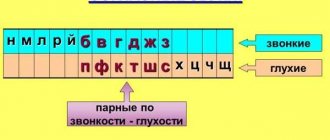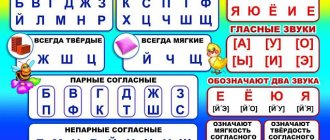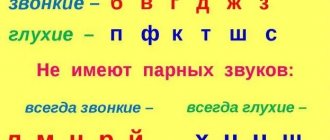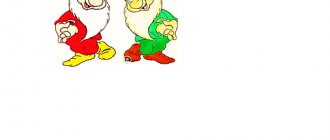Speech therapy lesson “Meadow of Deaf Sounds”
Logopists: Camilla V., Olga B., Anton K., Ainur A., Aliya T., Timur S. Lesson type: group lesson, lesson in applying knowledge and skills. Goal: Differentiation of paired sounds. Consolidation of voiceless consonants. Objectives: Correctional and educational: - develop phonemic hearing; — improve visual and auditory attention; — expansion and activation of the dictionary. Corrective and developmental: - develop the mobility of the organs of the articulatory apparatus; — develop inflection and word formation skills; - develop fine motor skills; - develop visual attention and memory; — continue to work on the formation of processes of language analysis and synthesis; Correctional and educational: - cultivate a tolerant attitude towards children’s answers; - develop the ability to listen to each other; - cultivate the desire to speak correctly, clearly, beautifully; — develop the ability to work in a team; - create positive learning motivation. Equipment: individual mirrors, bell, laptop, presentation “Funny Tongue”, presentation “Glade of Deaf Sounds”, diagrams-cards for determining the place of a letter in a word, pictures on the topic, coding cards, colored pencils, emoticon cards for self-esteem.
Progress of the lesson
1. Org. moment Speech therapist: The one who names the word in which the first sound is a consonant will sit down. II. Updating basic knowledge Speech therapist: What sounds are called consonants? Students: Consonants are those sounds when pronounced, the exhaled air stream encounters an obstacle. Speech therapist: What are the consonant sounds? Students: There are consonant sounds: hard and soft, voiced and voiceless. Speech therapist: Right. Let's talk about voiced and voiceless consonants. What consonant sound is called voiced? Students: A consonant sound that is pronounced with a voice is called voiced. Speech therapist: What consonant sound is called voiceless? Students: A consonant sound pronounced without a voice is called voiceless. Speech therapist: How can you feel whether a consonant is voiced or unvoiced? Students: You can put your palm on the neck, pronounce a sound, and if your palm feels trembling, it means your vocal cords are working, the sound is pronounced with your voice, it is ringing. If the palm does not feel trembling, then the vocal cords are not working, the voice is not formed, the sound is pronounced without a voice, it is deaf. You can make the sound with your ears closed. If there is a ringing in the ears, then it is a ringing sound. If there is no ringing in the ears, then the sound is dull. Speech therapist: Well done. 2. Introduction to the topic Speech therapist: Guys, I want to ask you riddles: I always walk in a circle, The circle is my face, And the arrows are my hands. (clock) This animal, seeing a cat, barks loudly at the window. Always spinning at your feet Red with spots (puppy) Who is that squeaking pee-pee from an eggshell? Maybe a chicken child? Hatching. (chicken) I arrange myself cleverly: I have a pantry with me. Where's the storage room? Behind the cheek! I'm so cunning! (hamster) Speech therapist: What sounds do these words begin with? Pupils: With consonant sounds. Speech therapist: Remember the answers. Students: Watch, puppy, hamster, chicken. Speech therapist: Name only the first sounds of these words Students: Ch, Shch, X, C Speech therapist: What did you notice? Pupils: Consonants, unpaired, deaf. Speech therapist: Correct. Name the paired deaf sounds Students: P, T, S, Sh, F, K Speech therapist: What are we going to do in class today? Students: Study voiceless consonants. Speech therapist: There are cards in front of you, words are encrypted on them. Each letter is assigned a number. Put the letters in order. The students perform. Speech therapist: No. 1, read the first word.
Paired by voicedness/voicelessness
There are 21 consonant letters in the alphabet, which represent 37 consonant sounds.
Many consonant sounds form voiced/voiceless pairs. Such consonant sounds can be voiced or devoiced depending on their position in words.
All voiced consonant sounds consist of noise and voice, all voiceless consonant sounds consist only of noise.
Let's list paired consonant sounds by voicedness/voicelessness using the table “Voiceless/voiced consonant sounds”:
| Voiced consonants | Voiceless consonants |
| [b] | [P] |
| [V] | [f] |
| [G] | [To] |
| [d] | [T] |
| [h] | [With] |
| [and] | [w] |
The correct spelling of paired consonants based on voicedness/voicelessness is an orthogram that requires a test word.
Let us give examples: the word “tooth” is pronounced with a dull consonant sound [p] like [zup]; the word “teeth” is pronounced with a voiced consonant sound [b] like [teeth].
Unpaired voiced
In the Russian language there are only voiced consonant sounds, that is, such consonant sounds are not paired, they do not have pairs of sounds due to deafness.
The sound of unpaired voiced consonants does not depend on position.
Unpaired voiced consonant sounds include: [l], [m], [n], [r], [th].
Let's give an example: the word “crowbar” is pronounced with unpaired voiced consonant sounds [l] and [m] like [crowbar].
Unpaired deaf
There are also consonant sounds that do not have a voicing pair. Such sounds are called unpaired voiceless consonants.
The sound of unpaired voiceless consonants does not depend on position.
Unpaired voiceless consonants include: [x], [ts], [h], [sch].
Let's give an example: the word “thicket” is pronounced with unpaired voiceless consonant sounds [h] and [sch] as [ch'ash'a].
How different are these consonant sounds?
There's a lot of trouble with letters, that's the kind of people they are.
Sounds change without asking and pretend to be different.
How much trouble these letters and sounds cause for children! Learn the letters, and then remember when and what sound they represent! And there are oh-oh-oh so many sounds. How can you remember all the voiced and voiceless consonants ?
Everything turns out to be very simple if you set up your child correctly.
I have already written about hard and soft consonant sounds. But consonants are not only hard and soft, but also voiced and unvoiced. And they cause so much trouble for children in the form of mistakes! How to teach a child to correctly identify voiced and voiceless consonants ?
Simply memorizing voiced and voiceless consonants is a losing proposition. Even if the child remembers, it will be very difficult for him to apply this knowledge. But if a child understands how voiced and unvoiced sounds are made, learns to hear them and identify them by their signs, then it will be easy for him to remember.
Let's first figure out the voiced and voiceless consonant sounds .
In the Russian language, consonant sounds are divided into voiced and voiceless, depending on the participation of the voice in the pronunciation of the sound. How to determine this? Say a single consonant sound and place your hand to your throat. If the vocal cords vibrate, it is a ringing sound. If not, then you are deaf. Check with your child and pronounce the sounds B - P, M or X. Did you notice?
Voicedness or deafness can be defined differently. Cover your ears with your palms and say a consonant sound. Did you hear a voice or noise? If a voice is heard, then the sound is ringing, if the noise is dull.
And this way you can easily and simply determine the voicedness or dullness of a consonant . At first, this method is very good. But if the child continues to determine the voicedness or deafness of a consonant in this way, then this will take a lot of time. The child will not have time to complete work in class. Therefore, it is necessary for the child to remember voiced and voiceless consonants.
And here we need to remember that the brain can perceive information in different ways - through hearing, vision or sensations. This means that in order for a child to remember information, it is necessary to influence all the child’s systems.
By determining the voicedness and deafness of consonants by ear, we have already included hearing in the work. By putting our hand to our throat, we connected the sensations. Now we need to connect our vision. To do this, you need to make a sign or drawing, where you denote the voiced and voiceless consonants with some symbols.
Voiced and voiceless consonants are paired and unpaired. This means that when creating such a diagram or tablet, you need to place paired consonants side by side. You can use any symbols that remind the child that the sound is voiced or unvoiced. So in this scheme, voiced consonants are indicated by a bell, and voiceless consonants are indicated by headphones.
Draw a similar sign with your child. Let him independently place the letters near the desired symbol, and you just control and guide the child’s actions. Remember that a person will only remember well what he did on his own.
Play with the placement of letters on floors or houses with the desired symbol several times and the child will perfectly remember the voiced and voiceless consonants. Hang this sign in a visible place and periodically return to it, ask the child to tell, show, name some sounds.
So, by playing, repeating already familiar properties of sounds and letters, you will help your child learn the basics of the Russian language without difficulty, remember voiced and voiceless consonants .
Have questions? Write in the comments to get an answer.
In the meantime, get some positivity and watch a wonderful cartoon. Let's learn from this cheerful monkey to find the good in everything.






